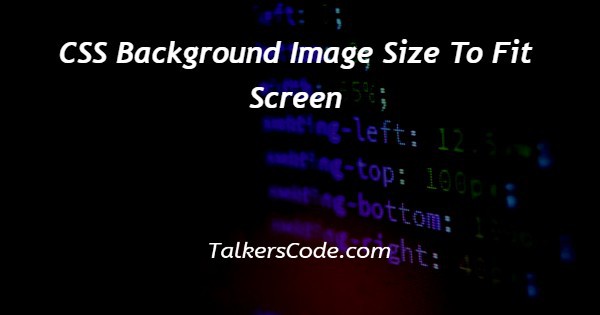CSS Background Image Size To Fit Screen
Last Updated : Mar 11, 2024
IN - CSS | Written & Updated By - Amruta

In this tutorial we will show you the solution of CSS background image size to fit screen, as we know css used to style html elements, here we inserted background image to body element by using style property ‘background-image’.
The url value contain path information of image to be set as background on webpage.
Using ‘background-size’ property we sets background image to entire screen of webpage and it has many options like ‘auto, contain or cover’ so we have to use which one has behavior to cover screen size.
Step By Step Guide On CSS Background Image Size To Fit Screen :-
We can implement styles using three types (i.e inline, external or internal) Internal means we have to define our style within <style> tag in head block and inline means we have use style within element definition, external means we defined our css at separate file with .css extension we have to import by <link> tag within head block.
Here we used internal style method and in our program we defined block of style properties to style body of html webpage.
First we have to sets body element width and height to ‘100%’ then only we can cover entire screen after that we have to insert background image then using ‘background-size’ property value to ‘cover’ we fits background to screen size.
<!DOCTYPE html>
<html>
<head>
<title>IMAGE SIZE TO FIT SCREEN</title>
<style>
body{
background-image: url("background.jpg");
background-size:cover;
background-repeat: no-repeat;
width: 100%;
height: 100%;
}
</style>
</head>
<body>
</body>
</html>
- <!DOCTYPE html> tag which is instruct the web browser about what version of HTML file written in.
- The<html> tag is used to indicate the beginning of HTML document.
- As above shown <head> tag is containing information about webpage and if you need any external file those links are declared here. <title> tag is used for set the webpage title.
- Here we defined styles to <body> element styles. The ‘width and height’ property used to cover screen size so we set’s value to ‘100%’ then ‘background-image’ property used to insert background.
- The ‘background-size’ property value sets as ‘cover’ used to fit background image size to screen size and ‘background-repeat’ property used to avoid image repeat which is occur only when our image size is too small it will repeatedly display same image to fill element size so we have to sets to ‘no-repeat’ value.
- Both <head> and <title> tags having their pair end tag, so we need to close the ending tags respectively. If you’re not closed anyone of ending tag properly that is also affect the webpage result.
- <body> tag is beginning of main coding part because it contain coding of entire website blocks and elements described here.
- Here we added all styles to <body> tag by as we seen earlier at point 4.
- Both </body>,</html> tags closed respectively. </body> tag indicates the end of body, Then </html> tag indicates the end of HTML document.
Conclusion :-
In conclusion we are able to know how to insert background image to fit screen using css.
When we have to fits background image to any screen size we need to use ‘background-size’ property to value ‘cover’.
Make sure uploading background image needs to presents in same location of file if your image presents in other folder then you have give within url brackets like foldername/imagename.
We can use other two values of ‘background-size’ property also but it had some difference let see about later.
I hope this tutorial on CSS background image size to fit screen helps you and the steps and method mentioned above are easy to follow and implement.













